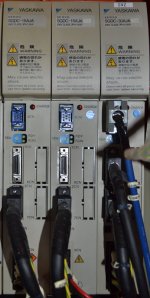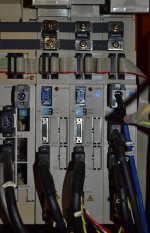DavidScott
Diamond
- Joined
- Jul 11, 2012
- Location
- Washington
I bought a 2001 Kitamura Mycenter 1xi in 2013. Of course it has a few issues and one of them is the Y axis servo motor hums when it stops moving. I have talked with a Kitamura national tech about this and he thinks it may be caused by weakened insulation on the servo, after ruling some other things out. To test this I need to get a megger since I don't have one. Before I do this I would like to run what I know about this mill past anyone interested and show some videos where you can hear the humming when I jog it manually, which is what make it hum the most. I also just got a free smart phone a month ago so I can take videos.
What is known:
Control is a Yasnac J300
I believe the machine has around 80,000 on hours, I think a lot of it was just sitting.
The machine ran straight oil for that first 80,000 hours.
If I screw the gibs in all they way they move .0005", so less than .0005" clearance.
Thrust bearings let the screw move a total of .0003" with a 300 lb load. There is .0002" of lost motion when I remove the load.
There is no measurable backlash in the nut with a 300 lb load. I have the backlash set to 0 in the control.
When it hums servo error does not exceed .001, resolution is 00.000. Hum lasts no more than 1-2 seconds at most.
Servo is connected to the screw with a solid steel connector. Connection to the screw is a key held by a set screw through the connector.
The hum is the same the entire axis travel.
All lube lines are flowing way oil.
When I indicate how much movement is lost from stick slip first thing upon startup I can get around .001" of commanded movement with the MPG in tenths mode before the table moves. After that first movement then only one or two tenths before the table moves.
I don't know how to embed a video yet so here is the link to the noisiest and a link to the video I did next that the machine quieted down some but better visual references.
Anyway I am about 80 miles from Portland Oregon and only know one machine tech but he is a sworn Fanuc guy so if possible I would like to figure this out myself with some help from this forum.
Thanks in advance for any help.
What is known:
Control is a Yasnac J300
I believe the machine has around 80,000 on hours, I think a lot of it was just sitting.
The machine ran straight oil for that first 80,000 hours.
If I screw the gibs in all they way they move .0005", so less than .0005" clearance.
Thrust bearings let the screw move a total of .0003" with a 300 lb load. There is .0002" of lost motion when I remove the load.
There is no measurable backlash in the nut with a 300 lb load. I have the backlash set to 0 in the control.
When it hums servo error does not exceed .001, resolution is 00.000. Hum lasts no more than 1-2 seconds at most.
Servo is connected to the screw with a solid steel connector. Connection to the screw is a key held by a set screw through the connector.
The hum is the same the entire axis travel.
All lube lines are flowing way oil.
When I indicate how much movement is lost from stick slip first thing upon startup I can get around .001" of commanded movement with the MPG in tenths mode before the table moves. After that first movement then only one or two tenths before the table moves.
I don't know how to embed a video yet so here is the link to the noisiest and a link to the video I did next that the machine quieted down some but better visual references.
Anyway I am about 80 miles from Portland Oregon and only know one machine tech but he is a sworn Fanuc guy so if possible I would like to figure this out myself with some help from this forum.
Thanks in advance for any help.






